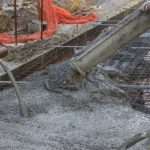Air entrained concrete has microscopic air bubbles in the concrete. Air bubbles provide durability for concrete exposed to freezing and thawing. These air bubbles help to improve the workability of the concrete and reduce the slump. Concrete entrained air testing is a must to maintain quality.
The Advantage of Air Entrained Concrete

Air entrainment is the deliberate creation of bubbles of air in concrete. The number of such air cells per cubic foot of concrete can be measured in the billions. This is done by addition of agents that entrain air and are generally chemicals. The air bubbles are produced when the concrete is mixed and continue to be a part of the concrete even after it hardens. Normal concrete will have small capillaries produced by the evaporation of the water in the concrete. These capillaries are invaded by water from the environment and the freezing of this water can cause a lot of stress in concrete because of the expansion in volume that accompanies the freezing. This causes further cracks and continued deterioration in the concrete. Air entrained concrete allows the expansion to take place without causing any further stresses, as the air bubbles are capable of being compressed. The bubbles also contribute to the workability of the concrete.
Image Source : Flickr : maddavethorp
The chemical surfactants that can be used for air entraining are many. Air entraining was first started in the 1930s for road making, and the civil engineers of that day found Vinsol resin that had been neutralized or other salts of wood resins effective for the purpose. Other synthetic detergents, petroleum acid salts, and salts from fatty and resinous acids have now joined the list of air entraining agents. Cement manufacturers also add these agents during the manufacturing process but such cement does not allow any changes to be made at the work site and also loses its effectiveness after storage. This has led to this practice largely falling out of favor.
How to Make Air Entrained Concrete and Test it for Air content
Air entrained concrete is made by adding a commercial agent to the concrete in the quantities that each manufacturer will specify. Dilution of the agent is not recommended unless it is specifically asked for by the instructions given with the agent. Portland cement is the right cement to use, and the air content has to be controlled so that mix is uniform.
It is likely that higher concrete temperatures will require more quantity of the air-entraining agent, and this requires frequent testing of the air content. Concrete needs to be mixed for at least 1 or 2 minutes. An increase in mixing time because of the distances to pouring site may increase the quantity of agent by a percent if the time of mixing goes over 5 minutes. It can however reduce if mixing time is more than 10 minutes. Vibrating of the concrete can further reduce air content by 15 to 20 percent, and this is more pronounced when the vibration is internal and not through external form vibrators.
Concrete entrained air testing is a must for such concrete. Air content of the freshly mixed concrete can be measured by gravimetric, volumetric, or pressure methods. The pressure method is the most commonly used, and in this method a calibrated air meter is used to test a known volume of concrete that is subjected to a defined pressure.
Slump and Concrete Strength of Air Entrained Concrete
During the making of concrete a slump test is mandatory and normally slumps of about 3 inches are used for good workability. However when air entraining agents are used, the slump can reduce to between 1 to 2 inches while still having the same desired workability. The air entrained concrete has a whipped cream effect that allows slump reduction. Engineers take advantage of this slump reduction to further reduce the water-to-cement ratio in the concrete which can increase the strength of the concrete.
Strength of air entrained concrete reduces 5 percent for every 1 percent of entrained air. This can be compensated by the reduction in the water-to-cement ratio or by reduction in fine aggregates, but these are matters better decided by structural engineers designing the structure. The reduction in strength comes from the voids caused by the entrained air.
The amount of entrained air is maintained between 4 and 7 percent for best freezing thawing resistance though variations can be made depending on specific conditions.


